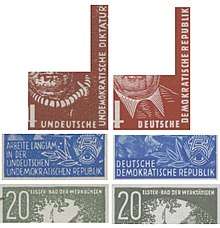Kampfgruppe gegen Unmenschlichkeit
The Kampfgruppe gegen Unmenschlichkeit (KgU) (German for "Combat Group against Inhumanity") was a German anti-communist resistance group based in West Berlin. It was founded in 1948 by Rainer Hildebrandt, Günther Birkenfeld and Ernst Benda, and existed until 1959.[1][2] Hildebrandt would later establish the Checkpoint Charlie Museum.
 Counterpropaganda produced by the KgU- the left is the fake and the right is the original | |
| Formation | 1948 |
|---|---|
| Founder | Rainer Hildebrandt Günther Birkenfeld Ernst Benda |
| Extinction | 1959 |
| Type | Resistance group |
| Purpose | To disrupt Communist activity in East Germany |
| Location |
|
Key people | Ernst Tillich |
History
The KgU received significant financial support from several Western intelligence agencies as well as the government of West Germany and the Ford Foundation.[3] The US Army's Counterintelligence Corps (CIC) provided funding from the group's creation in the late 1940s. By the early 1950s, the Central Intelligence Agency (CIA) gradually replaced the CIC as the KgU's most prominent American backer. According to CIA documents, the KgU ran approximately 500 agents in East Germany in the early 1950s, which, according to historian Enrico Heitzer, put it on par with the Gehlen Organization, the predecessor to the West German intelligence service Bundesnachrichtendienst.
The KgU's activities included sabotage, arson and poison attacks[4] as well as aggressive economic warfare, such as Operation Osterhase ("Easter Bunny"), in which the group sent 150,000 fake letters to East German stores, ordering drastic price cuts in order to cause a run on already scarce consumer goods. Other activities included collecting data on individuals imprisoned in East Germany and passing it on to their relatives, as well as collecting names of informers to the East German government and passing it on to RIAS, which would then broadcast so-called "snitch reports" in order to silence informers and discourage others from engaging in similar activities.
The KgU also aided the CIA in building up a so-called stay-behind network to be used in the event of a hypothetical Soviet invasion. Infiltration of the KgU by Stasi operatives and the arrest of several of its agents in East Germany eventually caused the group to dissolve in 1959, with many of its records going to the CIA.
Although some KgU members, such as Rainer Hildebrandt and Ernst Tillich, had served time in prison during the Third Reich for anti-Nazi activities, as historian Enrico Heitzer points out, the group also used numerous activists with a Nazi past, many of whom hadn't changed their political views.[5]
References
- http://www.dhm.de/ausstellungen/kalter_krieg/brosch_02.htm
- http://www.jugendopposition.de/index.php?id=2860
- Blum, William (2003). Killing Hope: US Military and CIA Interventions Since World War II. London: Zed Books. p. 62. ISBN 1 84277 368 2. Retrieved 15 October 2017.
combat groups against inhumanity cia.
- Boghardt, Thomas. "The Fighting Group against Inhumanity: Resistance and Espionage in the Cold War, 1948–1959 (German title: Die Kampfgruppe gegen Unmenschlichkeit (KgU): Widerstand und Spionage im Kalten Krieg 1948–1959) Enrico Heitzer (Bӧhlau Verlag, 2015)" (PDF). Retrieved 27 October 2018.
- Boghardt, Thomas. "The Fighting Group against Inhumanity: Resistance and Espionage in the Cold War, 1948–1959 (German title: Die Kampfgruppe gegen Unmenschlichkeit (KgU): Widerstand und Spionage im Kalten Krieg 1948–1959) Enrico Heitzer (Bӧhlau Verlag, 2015)" (PDF). Retrieved 15 October 2017.